

| Term | Description | ||||
|---|---|---|---|---|---|
| Apparent | A term used by PCGS Currency indicating a major problem with a note. The word, "Apparent" is printed with the grade and the problem is described on the holder. Also see the related term Net.
| ||||
| Auction | An offering to sell an individual item or group of items in which the price is determined by the highest bidder, sometimes with a reserve (minimum) price. | ||||
| Back Plate Number | A small number usually found at the lower right of the Back of a bill to uniquely identify the plate that printed the note — The back plate number is officially known as a Check Number.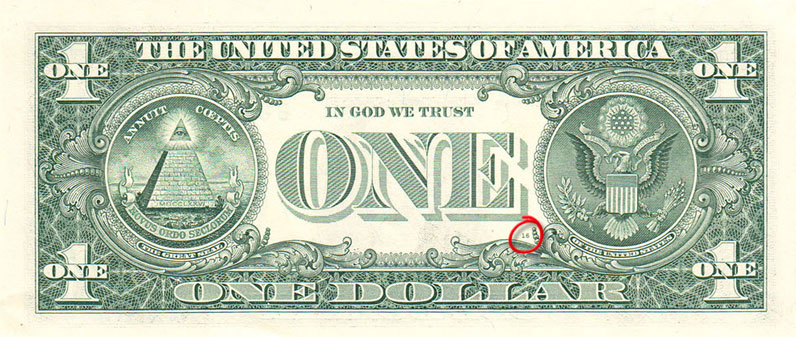 | ||||
| Bank Note | A piece of paper currency issued by a bank, rather than the federal government. | ||||
| Barrington Bonanza | The "Barrington Bonanza" is Jess Lipka's pedigree for a run of "large head" low serial number Star notes purchased from a collector living the the Barrington neighborhood of Chicago. | ||||
| Barr Note | At 28 days in office, Joseph W. Barr has served the shortest term of any Secretary of Treasury. As Under Secretary (1965-1968) to Secretary of the Treasury Henry H. Fowler, Joseph W. Barr was the Johnson Administration spokesman before Congress. When Fowler resigned in December 1968, Barr was appointed Secretary to serve the remaining month of President Johnson's incumbency. His signature appears only on the series 1963-B $1 Federal Reserve Note. The note isn't as rare as some would think — He was only in office for 28 days, but approximately 500,000,000 notes bearing his signature were printed! See: Presentation from the United States Department of the Treasury.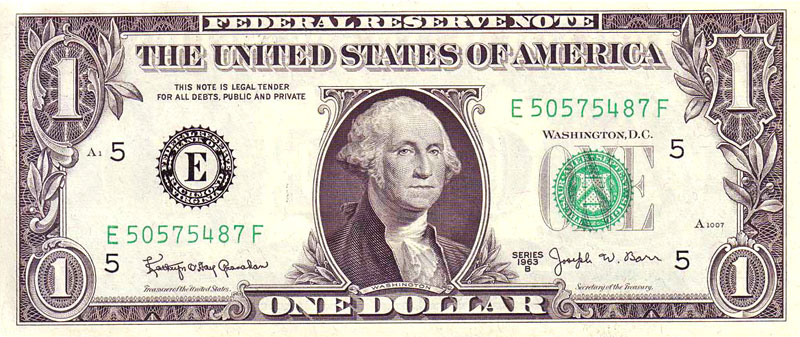 | ||||
| BEP | The Bureau of Engraving and Printing, established in the early days of the Civil War and formally recognized in 1869. Since 1887 it has printed all paper currency for the United States. Over its history, the BEP has also printed U.S. postage and revenue stamps, treasury bonds and food coupons. | ||||
| Big Head | See Heads. | ||||
| Binary Note | A note with a serial number that contains only two different numerals in random order, any combination or quantity — Such as 13113313 or 58888858.
| ||||
| Binions | 100 of the 383 $10,000 notes outstanding at the end of 1968, were located at Binion's Horseshoe.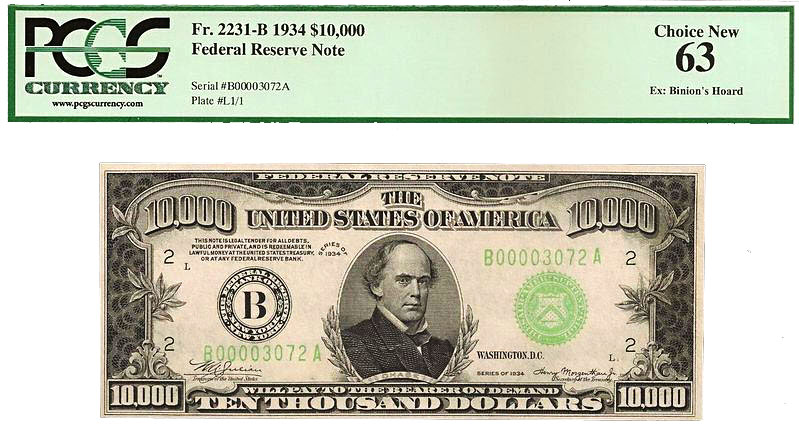
| ||||
| Birthday Note | A note with a serial number that represents a date.
| ||||
| Block | Prefix and suffix letter combination of serial number.
| ||||
| Blue seal | Nickname for Silver Certificates issues because of their distinctive blue seals.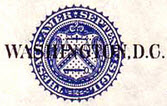 | ||||
| Boca Raton Run | The "Boca Raton Run" is Jess Lipka's pedigree for an offering of 11,900 PCGS graded Series 2006 Atlanta $1 FRNs, consecutive serial numbers F00000101 to F00012000A, most graded between 64PPQ and 66PPQ.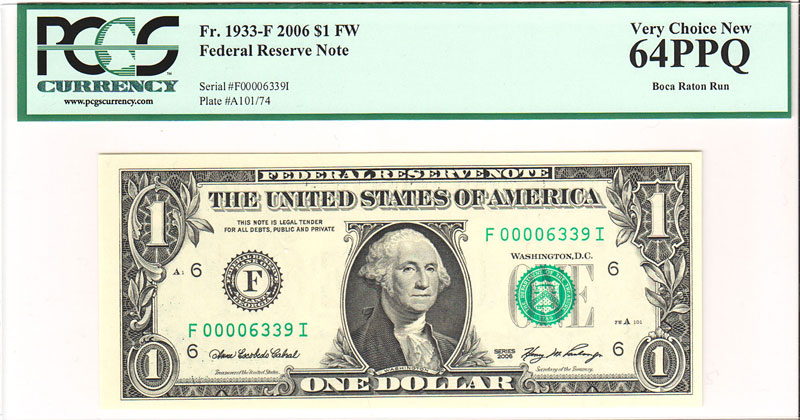 | ||||
| Bookends | Bookends occur when the same sequence of digits can be found at both ends of the serial number. For example, in the serial number 52194521, "521" is the sequence of digits occuring at both the beginning and end of the number and are called "bookends." Serial numbers 62043620 and 14555514 are bookend notes.
Bookends can also be notes in a consecutive serial number sequence at the beginning and end of a specific note. For example, the notes below have an inverted overprint note in the middle with (upside down) serial number K41980059C. The bookends have serial numbers, K41980058C and K41980060C. | ||||
| Border | The outer edge of the design on either the Face or Back of a note where the design ends and the plain currency paper outer margin begins. | ||||
| Brick | 4 bundles (4,000 notes) make a brick which weighs about 8½ pounds. | ||||
| Bundle | 10 straps (1,000 notes) make a bundle  | ||||
| Bundle Beginning and Ending Note Set | The beginning serial number of the note in a bundle and the ending serial number of the note in a bundle make a Bundle Beginning and Ending Note Set. The set is almost always presented with the BEP Bundle Label.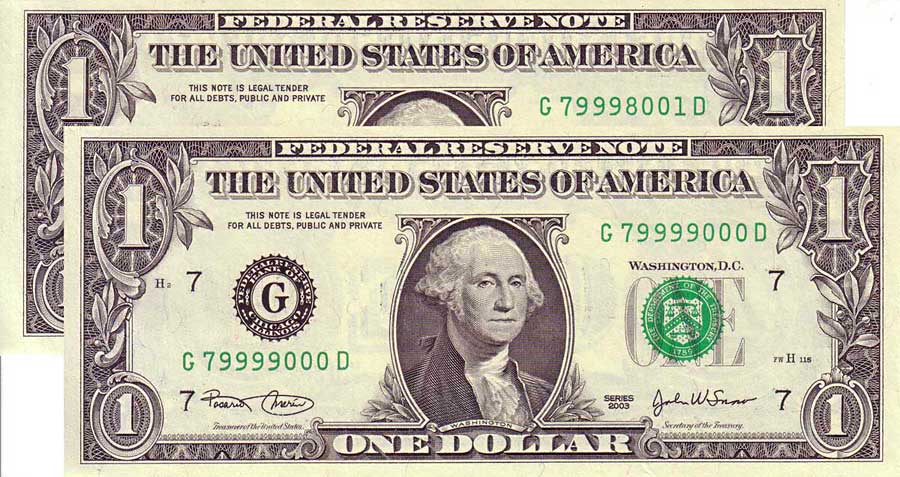 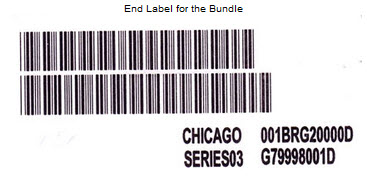 | ||||
| Butterfly Fold | Fold along the corner of a note which after the cutting process results in an excess flag of paper, sometimes roughly resembling a butterfly's wing. By strictest definition this refers to gutter folds only, however some dealers and collectors also lump in unfolded exterior folds and make no distinction as long as an additional paper flag is present.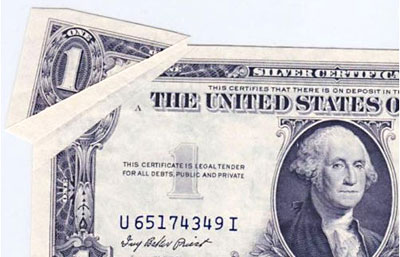 | ||||
| Cancellation | A mark on withdrawn notes from circulation by punch hole, perforation, cutting, overprinting, stamping or writing. | ||||
| Cash Pack | 4 bricks (16,000 notes) make a cash pack. | ||||
| Catalog Number | See Catalog Numbers. | ||||
| CGA - Currency Grading and Authentication | Currency Grading and Authentication (CGA), the country's first paper money grading service, was formed in 1998 in response to a high demand from collectors and dealers for an impartial third party grading service. CGA and the Trademark CGA brand were sold on 13 April 2009. The new company will retain the CGA name but display a * Star * on the back of every note certified by the new ownership.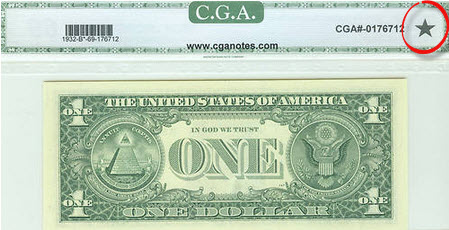 | ||||
| Chop or Chop Mark | Synonymous with counter mark or counter stamp. | ||||
| COPE-PAK | Currency Overprinting, Processing Equipment and Packaging. Machines employed by the Bureau of Engraving and Printing to first overprint currency, examine it for quality control, and then cut, band, and shrink-wrap the newly printed notes. The serial numbers for notes printed by the COPE system were slightly different than those printed on the older conventional presses — They were bolder and thicker. Serial number from conventional printing (top) and COPE system (bottom)
| ||||
| Counter Mark | A mark or device, struck randomly by hand with a punch, to a host coin. Usually to validate or hallmark a coin's authenticity. Thus, allowing it to circulate for commerce in a foreign country; not to be confused with a counter stamp. | ||||
| Counting Marks | Very light bends going into the note that aren't folds. | ||||
| Curse of the Duece | In the late 1800's some of the things you could do with a $2 note were: Buy a vote, Buy "services" at a brothel, or place a bet. Respectable persons feared others would think they had "earned" the "Duece" by selling their vote, their body, or as a habitual bettor. To combat the "Curse of the Deuce," many people tore corners off the note. Pregnant women who received a note with all four corners torn off believed they would have twins. Cashiers imagined themselves immune from the "Curse" if they kissed the note upon receipt ó In the old days, it was believed that saliva contained magical powers that would contain a curse long enough to pass the offending article to another who would have to fine their own way of defending themselves.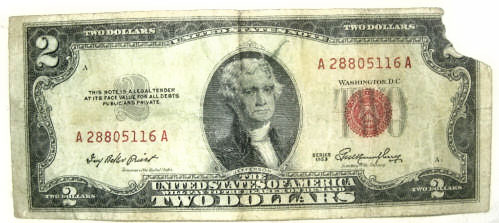 | ||||
| Demonetized | Money no longer accepted as legal tender. Officially withdrawn from circulation and no longer redeemable. Synonymous with Obsolete. | ||||
| Devices | The specific designs and images found on an item, not including letters and numerals; unless they are incorporated into the design, i.e. the word LIBERTY on the headband of a crown or shield. | ||||
| Double Quad | A "Double Quad" serial number has the first four digits all the same and the last four digits all the same, but a different number. By definition, a "Double Quad" is also a "Binary Serial Number".
| ||||
| Embossing | When the note's printing can be felt on the other side of the note (especially around the serial numbers and treasury seal). | ||||
| Emergency Issues | Officially sanctioned under emergency conditions, private or local business' issue legal tender. i.e. political or financial destabilization, war, etc. See: | ||||
| Engraving | Engravers engrave a web of fine lines and grooves into steel dies, transforming designer's models into three-dimensional engravings. Sharp tools (commonly called gravers) and acids are used to cut the fine lines, dots and dashes that uniquely describe the subject the engraver is creating. Additionally, the engraver must cut the image in reverse to how it will actually print on a highly polished steel die. Engravers do not work on a whole note design at once. They engrave separate parts of the design on separate dies. Some engravers specialize in portraits and vignettes, others in letters and script. | ||||
| EPQ | PMG uses the designation Exceptional Paper Quality (EPQ) for notes that, in the opinion of PMG graders, are original. By original, they mean that a note has not been physically, chemically, or materially processed to lend the appearance of a higher grade. PMG graders examine the embossing, inks, and overall integrity of each note to make the determination whether it will qualify for EPQ. Notes exhibiting normal wear-and-tear for their respective grades are eligible; normal wear may include factors affecting grade such as counting marks and folds. Notes receiving the EPQ designation must furthermore be unrestored. A restored note has had non-original material added to bring its appearance to a known or assumed state. For currency to grade Gem Uncirculated 65 or higher, it must also receive the EPQ designation. PMG indicates that typically 30 is the lowest grade that they will give and EPQ designation. However, they have had a limited amount of notes that they designated 25EPQ. | ||||
| Error Note | Currency that has a manufacturing mistake or misprint. | ||||
| Experimental Notes | A note or series of notes used to test various compositions of ink or paper or size for wear characteristics. In order for an experiment to be conducted, there must be a test group and a control group. Certain serial number ranges will comprise of the regular issue, and the other group will contain the test. This way, there is a standard of comparison. Experimental notes usually have a special identifying mark, such as the red "R" & "S" on the Series 1935A $1 notes, or special prefix/suffix US $1 Series 1928A & 1928B X-B, Y-B and Z-B prefix/suffix notes, 1935 A-B, B-B, and C-B so they can be identified easily. | ||||
| Fancy Serial Number | Notes with a desirable combination or arrangement of numbers — Bundle Beginning and End Note, Low Serial Number, Progressive (up) or Regressive (down) "Ladder" Serial Number, Radar Note, Repeater Note, Binary Note, Solid or Partial Solid Serial Number, "Quads", "Flippers", or a "Swims" Note. | ||||
| Fantasy Notes | Private issues manufactured for sale as a novelty item, which have no value as legal tender or trade value.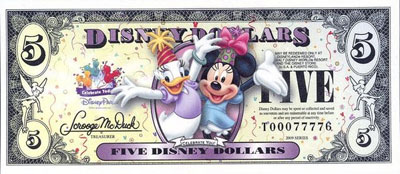 | ||||
| Federal Reserve Bank Note (FRBN) | A series of U.S. paper money once authorized by the Federal Reserve, now obsolete; not to be confused with Federal Reserve Note. The Federal Reserve Bank that issued the note, not the Federal Reserve System, was obligated to honor this note.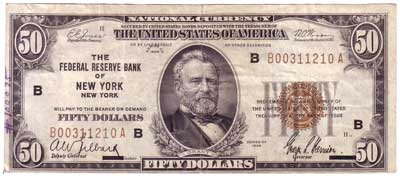 | ||||
| Federal Reserve Note (FRN) | The only form of paper money presently being printed in the United States; not to be confused with Federal Reserve Bank Note. The Federal Reserve System is obligated to honor this note, not the bank that released it into circulation.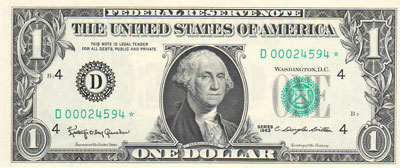 | ||||
| Filler | A very low grade and/or damaged item. The term may or may not be used in conjunction with a grade. Useful only in the case of a scare or rare item. In other words, if you do not have this item, you may want to consider it until a better one comes along. | ||||
| Flipper Notes | Note with a serial number comprised of numerals that can be read upside down as well as right side up: 0, 1, 6, 8, 9, but the serial number itself does not read the same upside down as right side up — A note with SN 06891109 right side up reads 60116890 upside down.
| ||||
| Foreign Exchange, or FX | A conversion of one country's current circulating legal tender into another country's current circulating legal tender. i.e. Pesos to Dollars | ||||
| Foxing | Yellow-brown aging stains on the paper. | ||||
| Fractional Currency | Official currency issued in fractional denominations of the single monetary unit. Usually due to a shortage of metal, thus restricting the striking of coins. | ||||
| Funny Back | The unique backs of Series 1928 and 1934 Federal Reserve Notes earned the nickname of "funny back" because the simple design looked like play money.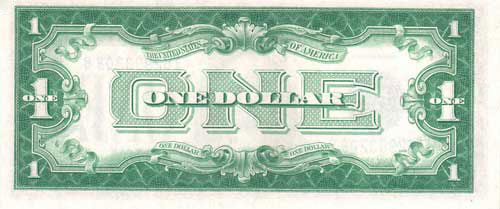 | ||||
| Gold Certificate | A form of U.S. paper money redeemable for gold coin at one time. Illegal to own between 1933 and 1964, they now are honored at banks, but can't be redeemed for gold coin. Highly prized by collectors.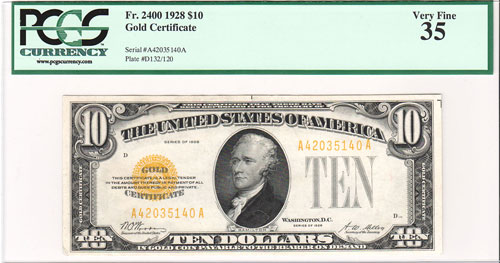 | ||||
| Grade | The condition or state of preservation of a piece of paper money. See: Grading Paper Money. | ||||
| Great Lakes Collection | Jess Lipka purchased a collection of high quality Chicago small-size Federal Reserve Notes from an estate and termed the pedigree, "Great Lakes Collection".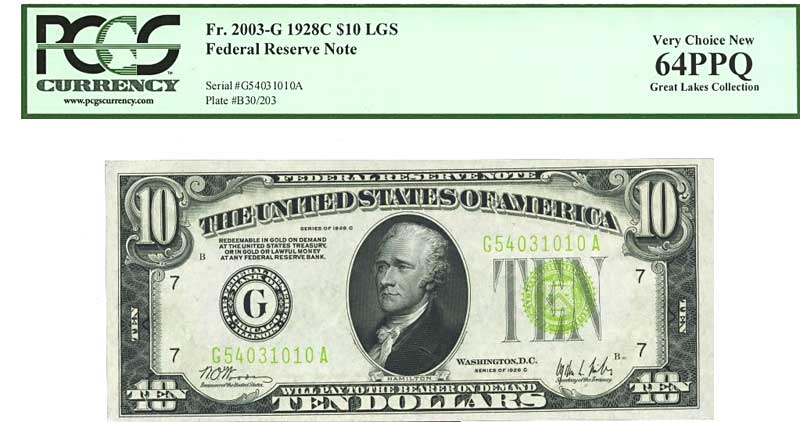 | ||||
| Greenback | Originally known as a Demand Note. Issued in 1861, it was the first note to have a green reverse or Back, establishing a tradition that exists today. Green ink was originally used as an anti-counterfeiting measure, because early cameras and film could not reproduce it. Today, Greenback is a common term for any U.S. paper currency. | ||||
| Guilloche | The geometric design printed as a security device.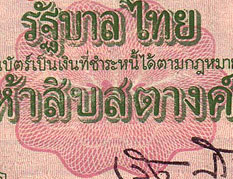 | ||||
| Gutter Fold | Pleat-like fold(s) during one or more of the printings, which when unfolded results in a blank unprinted strip (aka "interior fold").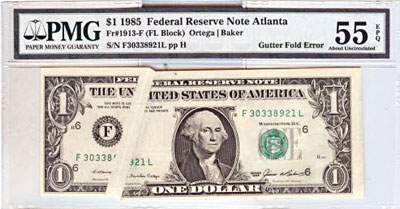 | ||||
| Handling | Minor disturbances in the paper other than folds such as teller counting marks, crinkles and minor bends. | ||||
| Heads | In the mid-to-late 1990's, the BEP completely redesigned notes of a denomination $5.00 and higher. The new design incorporated a larger portrait at the center of the note, and they were nicknamed "big head" notes. Conversely, prior series became known as "small head" notes.
| ||||
| Hologram | A special type of photographic film used in 3D imaging. These are sometimes used on notes as a security device although their use has been somewhat limited to date. It's a relatively new technology. | ||||
| Horseblanket | Originally known as a Demand Note. Issued in 1861, it was the first note to have a green reverse or Back, establishing a tradition that exists today. Green ink was originally used as an anti-counterfeiting measure, because early cameras and film could not reproduce it. Today, Greenback is a common term for any U.S. paper currency. | ||||
| Hotel Buyers Hoard | A "Cash for Gold" buyer had set up at hotels for a couple years buying everything, built a large collection of collectable notes, and sold it all to Jess Lipka. When Jesse had the notes graded, he used "Hotel Buyers Hoard" for the pedigree. > 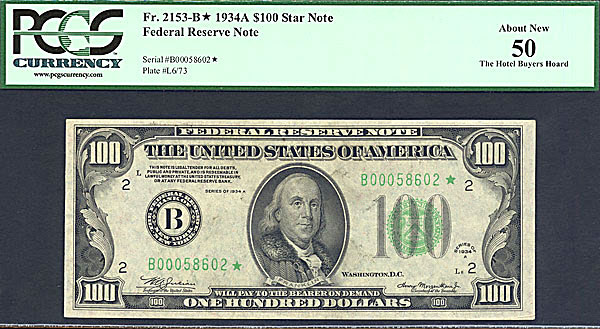 | ||||
| Hell Money | Fantasy notes used in ceremonial burial rites by the Chinese.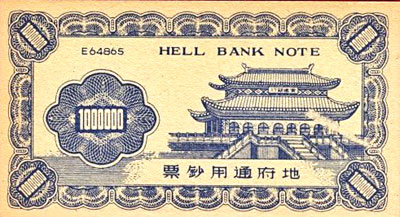 | ||||
| Holes | Pin or Staple: Tiny symmetrical holes found in paper money, script, and documents cause by staples or pins. Worm: Asymmetrical holes of varying size found in paper. Caused by larvae eating the paper, the result of improper storage.  Staple Holes | ||||
| Inflation Note | This type of note has an extremely high denomination and generally is seen in countries where massive inflation rates are occurring due perhaps to war or other severe economic pressures. Examples in the 20th century include post WWI Germany, post WWII Hungary and Yugoslavia, where multi-billion-dinara notes were issued a few years back, and Zimbawee, where trillion dollar notes were issues!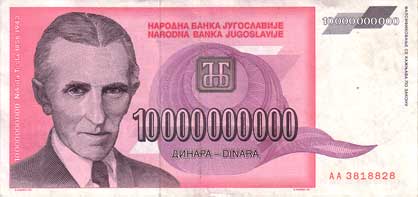 10,000,000,000 Dinara note from the former Socialist Federal Republic of Yugosalvia
| ||||
| Ink | All bills, regardless of denomination, utilize green ink on the backs. Faces, on the other hand, use black ink, color-shifting ink in the lower right hand corner for the $10 denominations and higher, and metallic ink for the freedom icons on redesigned $10, $20, and $50 bills. The $100 note's "bell in the inkwell" freedom icon uses color-shifting ink. These and the other inks appearing on U.S. currency are specially formulated and blended by the BEP. Inks headed for BEP presses also undergo continual quality testing. | ||||
| Intaglio | A printing method of three-dimensional character from engraved plates or dies. The printing of money begins with the hand-engraved piece of soft steel, known as a master-die. Separate portions of the design, such as the portrait, the vignette, the ornamentation, and the lettering are hand-cut by the engravers. If you look closely at a currency note, you will notice that the portrait consists of numerous fine lines, dots and dashes which vary in size and shape.The original dies are stored and transferred to a printing plate. The original dies are stored and if necessary may be used again and again. The master die is subjected to tremendous pressure, heated and an impression of the die is taken. An alto and/or relief (a raised image of the die) is cast in plastic. Multiple plastic images of the various components (such as the decorative scrollwork) of the note are made, fitted and welded into the necessary plate configuration consisting of thirty-two notes. Plastic altos are placed in an electrolytic tank and are used to produce a series of plates, which are then cleaned, polished, and carefully inspected by an engraver. If the plates pass the scrutiny of the engraver, the final chromium coated basso (recessed image) plate is made and another multiple subject intaglio plate is ready to place on the printing press. Each sheet is forced, under extremely heavy pressure (estimated at 20 tons), into the finely recessed lines of the plate to pick up the ink. The printing impression is three dimensional in effect and requires the combined handiwork of highly skilled artists, bank note engravers, and plate printers. The surface of the note feels slightly raised, while the reverse side feels slightly indented. | ||||
| Jogger | Sheets that were printed from the Back Intaglio process require 72 hours to dry and cure. During this drying process, the sheets bond and stick together. Therefore the sheets must be separated and neatly jogged before they can be printed on the Face Intaglio press. To do this the BEP employs automated joggers shaped much like the letter "C." Support personnel retrieve the load and place it into the jogger. The load is turned on its side and, through the combination of vibration and forced air, the sheets are separated. The process takes approximately 10 minutes. Once jogged, the load is moved to the designated Face Intaglio press. | ||||
| Ladder Note or Ladder Serial Number | A note with a serial number that is ascending (progressive) or descending (regressive) — For example: 34567890 or 09876543.
| ||||
| Large Head | See Heads. | ||||
| Large Size | Refers to U.S. paper money that measures 7 3/8 inches x 3 1/8 inches, issued 1861 to 1928. | ||||
| Legal Tender Note | Also known as United States Note — The longest-lived type of U.S. paper money, Legal Tender was authorized by the U.S. Government in 1862 and last issued in 1969.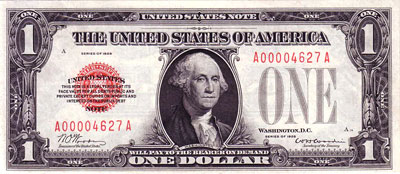 | ||||
| Lithograph | Also known as Offset printing. A method of surface printing with a thin flat layer of ink. The background colors are printed by the BEP's Simultan presses, which are state-of-the-art, high-speed, sheet-fed rotary offset presses. These presses are over 50 feet long and weigh over 70 tons. They are specifically designed to print security offset designs on currency paper. Using dry offset plates, ink from the plate is transferred to an offset blanket. The blank sheet of paper passes in-between the face and back blankets and simultaneously prints the complete image on the paper. The press has eight print units, four on the face and four on the back, with two comprehensive computer control consoles. Many of the press settings can be controlled from these consoles and their status displayed on the computer screens. The press is capable of printing 10,000 sheets per hour; approximately every 500 impressions, the pressmen will pull a sheet and carefully examine it to ensure that all the colors are remaining consistent. These sheets are stored for 72 hours to dry before going on to the next section, Intaglio printing. Drying occurs in Work-In-Process security cages, otherwise known as WIP cages. On average, the BEP inventories 2,000,000 sheets (or 100 loads) between Offset Printing Operations and the Back Intaglio printing operation. | ||||
| Low Serial Number | A note with a serial that starts with multiple zeros, i.e. 00, 000, 0000, 00000, 000000. Most serial numbers on bank notes contain at least 6 digits, and most collectors consider serial numbers that start with 4 zeroes or more to be low, while others collect with 3 zeroes or more, i.e.: J00000222J, or B00001335B, or F00049561F. General rule of thumb, if the note has the first half of the serial numbers with zeroes, it's a low serial number note.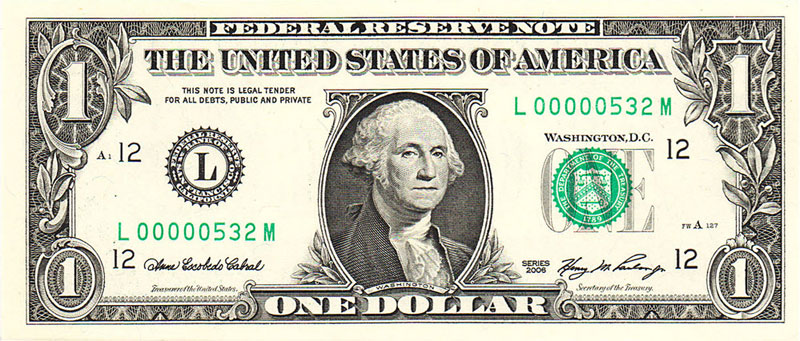 | ||||
| Miami Beach Hoard | Approximately 2,000 notes found by a contractor remodeling a 1920's home in Miami Beach. The notes were discovered stashed in a wall behind a bathroom sink in several large bundles, each bundle wrapped in cloth. See: Miami Beach 1930s hoard of notes in original bank bands. | ||||
| Micro-Printing | The tiny printing (letters can be six to seven thousandths of an inch high) found in various areas of some U.S. paper currency. Since most photocopiers and scanners cannot capture such small detail, this is an effective anti-counterfeiting measure.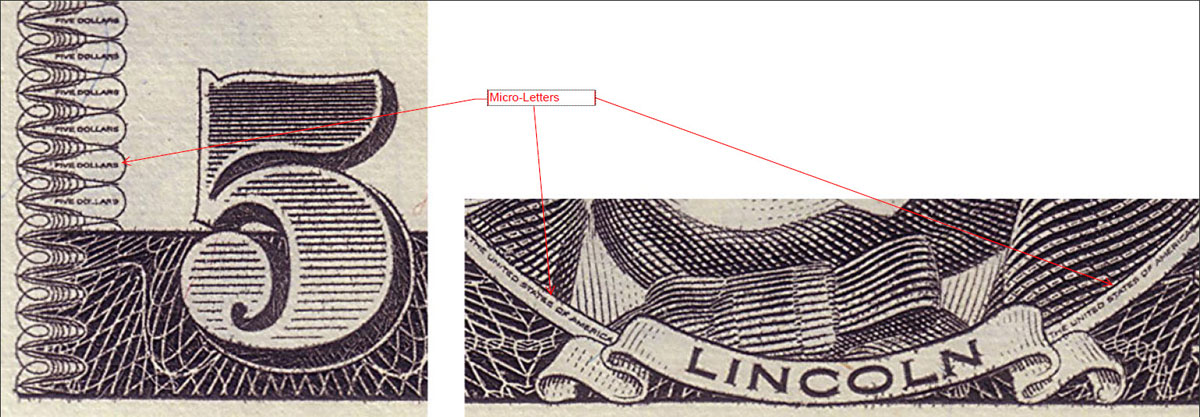 | ||||
| Misaligned Digit | A "Misaligned" or "Turned" Digit error is an improperly turned character in serial number that is out of alignment with the other numbers by at least 25%.
| ||||
| Mismatched Serial Numbers | Note which has a different serial number on the left and right sides of the note. May be one or multiple numeral/letter/character different.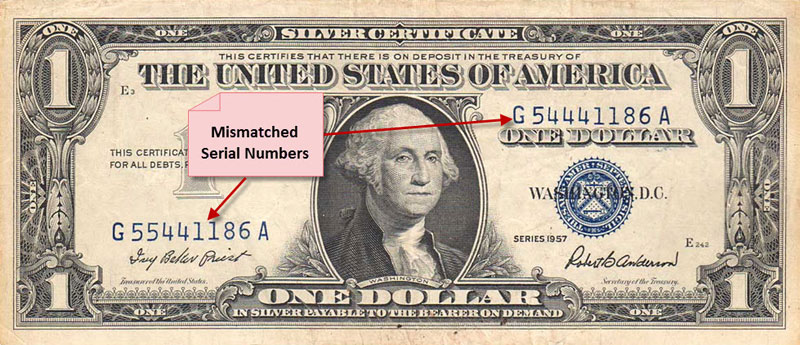 | ||||
| MPC | Military Payment Certificate. Official notes issued to military personnel stationed overseas for use in local commerce. 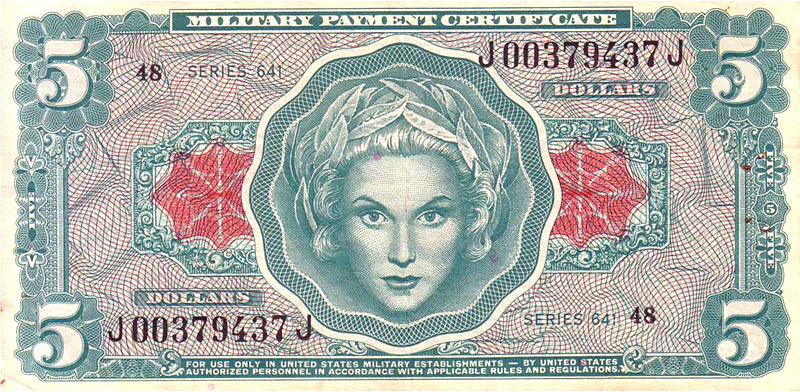 | ||||
| Mule Notes | See: Mule Notes. | ||||
| National Bank Note | Also known as National Currency. Most extensive paper money series in the nation, issued by government chartered national banks in the U.S. from 1863 to 1935 and secured by government bonds. With the National Banking Act of 1863 during the Civil War, over 14,000 banks were permitted to issue and circulate their own currency. Likewise, printing was also done at the U.S. Government Printing Office. All designs were similar with only the names of the banks, state seals, bank signatures and the bank's charter number creating difference. Every charter bank was given the right to issue currency up to 90 percent of the value of bonds that it held on deposit with the government. With a bond deposit equaling the printed currency, the National Bank Note gradually became accepted by the general public. This era lasted until the stock market crash of 1929 which ruined a vast number of banks and ended the public's confidence in this form of note. | ||||
| National Motto | "In God We Trust," the national motto of the United States; added to the Back of paper currency in 1957. See: National Motto.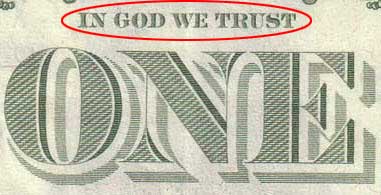 | ||||
| Net | PMG defines a "net graded" note is one which has had an adverse occurrence after it left the BEP. PMG will specifically state the reason(s) why any note is net graded. The PMG guarantee is not valid on any net graded note. A few reasons why a note may be "net graded" are tear, corner missing, repaired, re-embossed, washed, stained, rust, ink or writing, and PVC damage. Also see the related term Apparent.
| ||||
| Notaphilist | A collector of banknotes, paper money, paper currency or plastic notes. | ||||
| Notaphily | The study of paper money or banknotes. | ||||
| Nota-Sav | Nota-Sav is the BEP's examining equipment utilized to examine the $1 product line. Since those bills have neither a security thread nor a watermark, Nota-Sav does not need the technical sophistication of UOCIS. Using electronic examination "eyes" to inspect the sheets, these inspection systems provide the automated means to process the $1 bills as they move forward on a transport. With either the UOCIS or Nota-Sav inspection equipment, the 32-subject sheets are trimmed and split in half to create two 16-subject sheets. The sheets are stacked into two piles of 10,000 good sheets while the rejected sheets are reconciled and later scheduled for destruction. | ||||
| Note Position Number | The Note Number Position appears in the upper left quadrant. It is a letter number combination that indicates which position on the plate the note was printed. The number indicates the quadrant and the letter indicates the position within the quadrant.
| ||||
| Numerical grading | The Sheldon 1-70 scale employed by NGC, PCGS, and other third-party grading services. See: Grading Notes. | ||||
| Numismatics | The science of money. Coins, currency, tokens, inscribed bars, and all related items are numismatic. | ||||
| Numismatist | One who studies or collects money. | ||||
| Obsolete | See Demonetized. | ||||
| Obstructed Printing | Note missing a portion of a printing or printings because material, usually paper, falls between the printing plate and note.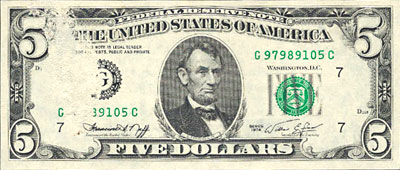 | ||||
| Occupation Money | Money issued by a post battle occupying country and used in the occupied country to replace the local legal tender — See Japanese Occupation Notes | ||||
| Offset | Wet ink transfer, normally in a mirror image, of a portion of one side's design onto the other side. This occurs when currency paper is not fed properly and ink ends up on the printing press cylinder instead of the intended currency sheet. The still wet ink on the cylinder is then transferred to the next sheet(s) to come in contact with it. Likely the most common misprint encountered on modern U.S. currency.
| ||||
| Outmoded | Legal tender officially withdrawn from circulation and no longer accepted in trade. However, for a finite time period, redeemable at the central banks. At the end of this period, it is demonetized. | ||||
| Overprint | Two definitions:
| ||||
| Palletizer | In 2008, an ergonomic piece of equipment called a palletizer was added to each one of the COPE-Pak presses to eliminate the repetitive, rotating motion performed by an employee as they placed the bricks onto skids. As the bricks enter the palletizer, they are flipped over and the barcodes are scanned for information. An air-powered arm picks up the bricks from the transport using vacuum suction in addition to forks and grippers. The palletizer will stack 160 bricks to complete two skids and then place a lid over them. It will then advance the full skids forward, where they will be secured and stored for the next operation. As full skids are advanced and removed, the palletizer will continue grabbing empty skids, placing them into position to start receiving more bricks. | ||||
| Panama Run | Jess Lipka obtained two bricks, and choice serial numbers from the next 10 bricks from a group of notes exported to, then imported from Panama. Someone in Panama bought these bricks and sold them to a dealer who subsequently sold them to Jess. He graded them and chose a pedigree of "Panama Run" and had them graded by PCGS and CGA.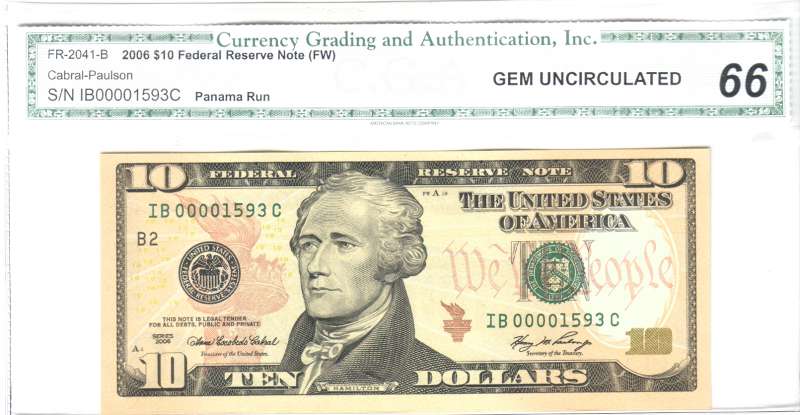 | ||||
| Paper | The paper comes to the BEP in brown paper-wrapped loads of 20,000 sheets (2 pallets of 10,000 sheets). Each of these sheets is tracked by the BEP as it passes through the production process. And, the total inventory of 20,000 sheets is continually reconciled to make sure each sheet is accounted for. Currency paper is specifically made for the BEP by Crane Paper Company. The ordinary paper that consumers use throughout their everyday life such as newspapers, books, cereal boxes, etc, is primarily made of wood pulp; however, United States currency paper is composed of 75% cotton and 25% linen. This is what gives United States currency its distinct look and feel. For denominations of $5 and above, the security thread, and watermark are already built into the paper when it is received. | ||||
| Paper Wave | The light ripples that should go across the top and bottom of a note, this is a result of wet paper drying after the printing process. | ||||
| PCDA | Professional Currency Dealers Association. | ||||
| PCGS Currency | PCGS Currency is the market leader in third-party grading and authentication, grading more than 400,000 notes since founded in 2005. | ||||
| Pedigree | The "pedigree" field on the label of a certified graded note may be used to indicate the collection name but it is not specifically designated for highlighted collections typically referred to as "pedigrees." Many collectors like to have their names tied to their collections and, while this is allowed, not just anything may be put on the label / holder. It should also be noted that although this field may add value to certain notes, it is not the primary purpose of the field. | ||||
| Pinches | Similar to counting marks but they occur internally on the note. | ||||
| Planchet | A blank, flat metal disk ready to be stamped as a coin or medal. Also dots printed on notes | ||||
| Plate Number | The small number at the lower right of a note's Face; identifies the Printing Plate from which the note was produced.
| ||||
| PMG | Paper Money Guaranty is the most comprehensive third-party paper money grading and encapsulation service. PMG combines accurate, impartial and knowledgeable paper currency grading professionals with proven processes and standards for the care and evaluation of your notes. | ||||
| POW Notes | Prisoner Of War. Money issued for exclusive use in a POW camp. | ||||
| PPQ | PCGS affixes a "PPQ" (Premium Paper Quality) designation to the grade (e.g., "Gem New 65PPQ"). These are notes that bear no visible evidence of restoration and that retain all signs of fully original paper quality, such as paper wave, embossing, and bold ink color and eye appeal, and that also have above average paper for the grade that is free of defects such as tears, pinholes, or other problems. This is not done to penalize those notes that are not fully original, as many are very collectible and highly valuable. Instead, this system is designed to reward those notes, both circulated and New, that possess premium paper quality and complete originality. It should be understood that even though a note may be fully original and free of any restoration, it still might not qualify for the "PPQ" designation. PCGS has graded a note as low as 20 with a PPQ designation. | ||||
| Proof | Paper: The final full or partial printing of a note or document before authorizing a general issuance. Checking for errors. | ||||
| Propaganda Notes | Usually a facsimile note, issued during wartime. with a propaganda message printed on one side. | ||||
| Quad | A "Quad" note is a note with a serial number which has four sequential same digits. See related term Double Quad.
| ||||
| Radar Note | A note with a "reflected serial number — The first four digits of the serial number are in reversed order of the last four digits.
A "Super Radar" is a radar in which the middle six digits are all the same (it is also a "Binary Radar")
A "Mirror Image Radar" is the serial numbers of two notes combined to form a radar serial number
| ||||
| Rag | A very well-worn piece of paper money, generally in an uncollectible state except for rarer issues. | ||||
| Ragpicker | Colloquial term for a paper money collector. | ||||
| Red Holder | Prior to 24 October 2007, PCGS Currency encapsulated notes classified as "Apparent" (notes that have major faults such as tears, splits, holes, missing pieces or have been subject to major restoration, such as repaired tears or splits, redrawing of the design, bleaching of the paper, or even reconstruction of missing pieces) in a "Red Holder".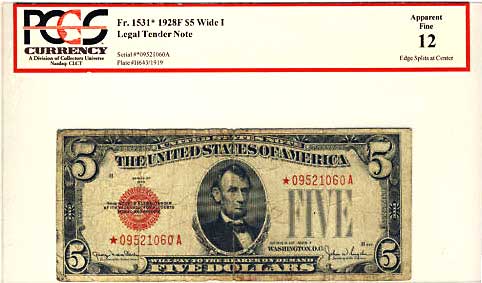
| ||||
| Red seal | Nickname for United States Notes/Legal Tender issues because of their distinctive bright red seals.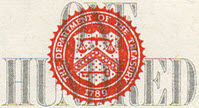 | ||||
| Registration | Alignment of the face and back printing. | ||||
| Remainder | Leftover original notes which were not put into circulation. Usually without signatures, numbers, or date. | ||||
| Repeater Note | A note with part of the serial number repeated — In the example below: 8136 8136
A "Super Repeater" is a repeater in which the first two digits are repeated four times. Examples are: 03030303 and 25252525.
A "Radar Repeater" is both a radar and a repeater. Examples are: 87788778 and 26622662.
| ||||
| Replacement Notes | A special printing run to replace damaged notes. Usually annotated by a special device, i.e. a star, letter, or special character — See Star Notes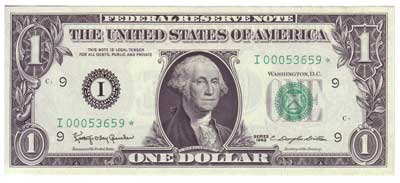 | ||||
| Rickey Collection | Dave and Brenda Rickey (DBRCurrency.com) once had a collection of over 93% of all possible large-size Friedberg numbers. The collection consisted of approximately 450 notes valued at approximately $15 million! Included in the collection are numerous landmark rarities that have record-setting potential. An 1890 $1,000 Treasury Note, one of only three examples of the "Grand Watermelon" type known in private hands, is included, as are examples of the extremely rare 1863 $500 and $1,000 Legal Tender Notes. Also graded were a $500 and $1,000 from the 1880 Silver Certificate Series, each example one of just two notes of each denomination known in private hands.
| ||||
| Rolled Digit | A "Rolled", "Gas Pump", or "Stuck" Digit error occurs when the digit is so far out of alignment that either a portion is not printed or displays portions of two different digits.
| ||||
| Second Printing | The face design, excluding such elements as serial numbers, etc., which is printed after the back, and generally includes borders and portrait. | ||||
| Security Thread | An anti-counterfeiting measure; a polymer strip is embedded in the currency paper and is visible when the note is held up to bright light. The thread glows red when exposed to ultraviolet light, and cannot be reproduced by photocopiers or scanners. Click for large image | ||||
| Serial Number | The serial number is a control or tracking device on all U.S. paper currency. It is located below the left center or above the right center on each bill. No two bills are alike and serve not only as an aid in counting but as a device to minimize counterfeiting.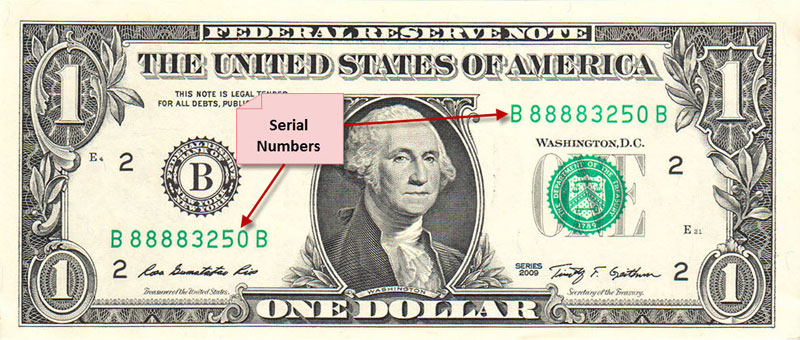 | ||||
| Series | Notes are dated when they were authorized or first issued. Notes carry that same date throughout their lifespan. | ||||
| Sheldon Scale | The Sheldon Scale is a 70-point scale for grading coins, developed by Dr. William Sheldon in 1949. A slightly modified form of the Sheldon Scale has become the de facto standard for grading U.S. coins today, and is used by the major third party grading services when assigning a grade to a coin. | ||||
| Short Snorter | A short snorter is a banknote which was signed by various persons traveling together or meeting up at different events and records who was met. The tradition was started by bush pilots in Alaska in the 1920's and subsequently spread through the growth of military and commercial aviation. If you signed a short snorter and that person could not produce it upon request, they owed you a dollar or a drink (a "short snort", aviation and alcohol do not mix!).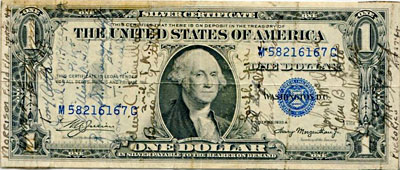
| ||||
| Siderography | In simplest terms, siderography is the means by which multiple images of the hand-engraved die are transferred to a printing plate.
In siderography, individually engraved elements such as the portrait, border, counters and text are first combined like pieces of a jigsaw puzzle to form one complete face (or back) of a note using a transfer press. Siderographers use this machine to exert as much as 4 tons per square inch to transfer the original work to a master die. Later, individual plastic molds are made from the master die and are assembled into one plate containing 32 exact duplicates of the master die. Plate makers will then process this plate to create the metal printing plates that go on the presses. After the dies are assembled and reproduced on plates, engravers cut in additional items, such as series, quadrant numbers, and signatures into the plates using a pantograph machine. A pantograph copies the die engraving onto the plate. As one part of the machine traces the original engraving another part engraves the image onto the new plate. The original engraved dies are stored and can be used again and again as needed. For example, the Lincoln portrait on the Series 1928 $5 note was originally engraved in 1869, but can still be used to make new dies today. | ||||
| Siege Notes | Emergency money issued during a siege of a city. | ||||
| Signatures | Beginning in 1861, the signature was originally placed on bills as a deterrent to counterfeiting and as a symbol of authorization. The assumption was made that a hand signature was more difficult to copy than an engraving and could be easily detected. From 1862 to 1923, two signers were required, the Treasurer and the Register or those who signed for them.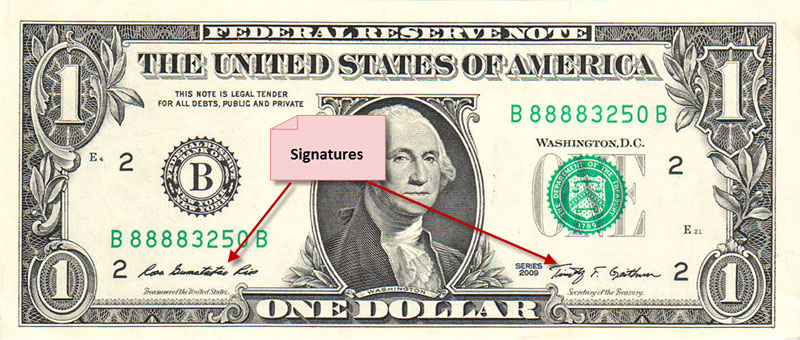 | ||||
| Silver Certificate (SC) | Authorized by the U.S. government in 1878, it is the second longest-lived paper money series. Once redeemable for silver coins or silver bullion, it is still considered legal tender at face value but is no longer redeemable for silver. See Silver Certificate.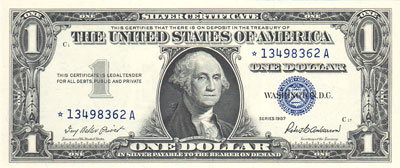 | ||||
| Skid | 40 cash packs (640,000 notes) make a skid. | ||||
| Small Head | See Heads. | ||||
| Small Size | Refers to modern U.S. paper currency that measures 6 1/8 inches x 2 5/8 inches, first issued in 1928. | ||||
| Smudges | The result of skin contact to ink surfaces. | ||||
| Solid and Partial Solid Serial Numbers | A serial number on a note comprised of a single numeral throughout the entire serial number regardless of the number of digits in the serial number — For example: 111111111, 22222222, 33333333, 44444444, 55555555, 66666666, 77777777, 88888888, 99999999. A solid 00000000 is usually reserved for specimen or essay notes. Solid serial number notes are perhaps the most sought after and easily recognizable fancy serial number notes. A partial solid contains two groups of the same numeral. i.e.: 22224444, 00000222 or 11111117. Differs from a binary note, where two of the same numerals are mixed throughout the serial number. See related term Binary Note.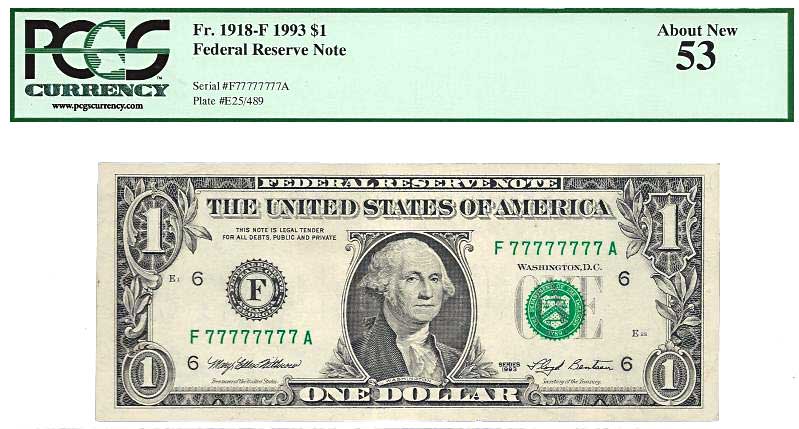 | ||||
| SOI | Super Orlof Intaglio — In the summer of 2008, the BEP's Washington, DC facility began to print $20 notes on the new Super Orlof Intaglio (SOI) presses. These are the presses that will eventually be processing 50-subject sheets, but at the moment they are still producing 32-subject sheets for compatibility with the existing overprinting equipment. The $20 notes printed on the SOI presses can be distinguished by their oversized face plate numbers, which appear similar to the back plate numbers used on Fort Worth plates. For additional information, see SOI Press $20 Notes.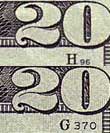 Note printed on older press at top Note printed on SOI press at bottom | ||||
| SPMC | Society of Paper Money Collectors — A corporation organized exclusively for educational purposes, and in furtherance of such purposes to promote, stimulate, and advance the study of paper money and other financial documents in all their branches along educational, historical and scientific lines. | ||||
| Specimen Notes | Samples of original banknotes distributed between banks to familiarize the staff with new designs or issues. Usually with over prints, cancellation or special numbers. Sometimes issued for collector purposes. See: Specimen Banknotes | ||||
| Stamp Currency | Revenue or postage stamps used as emergency money. | ||||
| Star Note | See Replacement Notes. | ||||
| Storage | See Paper Money Sleeves and Holders. | ||||
| Strap | 100 notes make a note strap.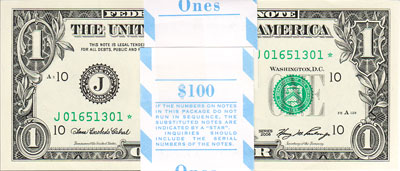 | ||||
| Stuck Digit | See Rolled Digit. | ||||
| Super Orlof Intaglio | See SOI. | ||||
| Swims Note and Swimmers | A a note, in which the serial number reads the same upside down, as it does right side up. Only numerals that read upside down can be part of the serial number: 1, 6, 8, 9, 0 — For example: 00196100, 10688901... | ||||
| Syngraphics | A word coined in 1974 by Gene Hessler to denote the study and collecting of paper money; based on the Latin word syngrapha, meaning a written promise to pay. | ||||
| Thomas M. Flynn Collection | The Thomas M. Flynn Collection of U.S. and Canadian Currency included more than 1,000 large size notes encompassing nearly every Friedberg number from one through 1225! Tom Flynn has been a familiar face to nearly everyone in the currency field for more than four decades. He started collecting United States currency in the mid-1960ís and expanded his collecting focus to include Canadian currency a few years later. Unlike most collectors of his day, who were content to collect by seal type or signature combination, Tomís horizons were much wider, as he soon decided his goal would be to own an example of every United States note issued by Friedberg number and every Canadian note issued by Charlton number. While no collection can ever be complete, Tom pursued his dream with passion for more than four decades, with truly marvelous results. | ||||
| Third Printing | For United States notes, the third printing is the final printing of the Treasury Seal and serial numbers. This non-intaglio printing process is now done with the COPE system. | ||||
| Turned Digit | See Misaligned Digit | ||||
| Uniface | Banknote with printing on one side only. | ||||
| UOCIS | The Upgraded Offline Currency Inspection System, otherwise known as UOCIS, integrates computers, cameras, and sophisticated software to completely analyze an untrimmed printed sheet. By examining untrimmed sheets, the BEP is better able to monitor color registration and ink density. As the sheets pass through the system at the rate of about 8,000 sheets per hour, a transmissive camera is used to inspect the paper by looking through the sheets to ensure the thread and portrait watermark are in the correct position. In addition, two separate cameras take a digital picture of both the front and back of the sheets, breaking the images down into four million tiny pixels. After the sheets are trimmed, a trim camera takes measurements of the sheets. All data is gathered from the sheets and compared to what is considered a perfect "golden image," and within three tenths of a second, the computer decides if the sheet is acceptable or a reject, looking for defects such as ink spots, ink deficiencies, or smears. | ||||
| Validation | Official endorsement in the form of perforation, hand stamp, adhesive stamp, tax stamp, etc. | ||||
| Vignette | Any picture or scene on a note other than a portrait. | ||||
| Watermark | A hidden design in paper that is visible only when the paper is held to the light. Used as a security device in currency and official documents.
| ||||
| Web Notes | The Bureau of Engraving and Printing (BEP) began testing a new web intaglio press in May 1992. Only $1 Federal Reserve Notes were used in this experiment that was performed only at the BEP facility in Washington, DC. This press would use a large roll of paper instead of sheets of paper and would also print both sides of the paper money at once, leaving the green Treasury seal and serial numbers for a later printing on a different press. Due to a different configuration of 96 subjects to a web-printing cylinder as compared to 32 subjects for printing a regular sheet of currency, changes were made to the format for front and back plate numbers. The front plate number remained in the lower right-hand corner, but the preceding letter was dropped. The position of the back plate number was moved from below the "E" in "ONE" to above the "E" in "ONE" and to the right of "Trust." | ||||
| Waliluku Hoard | Also seen spelled as "Wailuku", the Waliluku Hoard is Jess Lipka's offering of mostly Hawaii WWII War Emergency Notes obtained from the Yamaguchi brothers in Waliluku, Hawaii.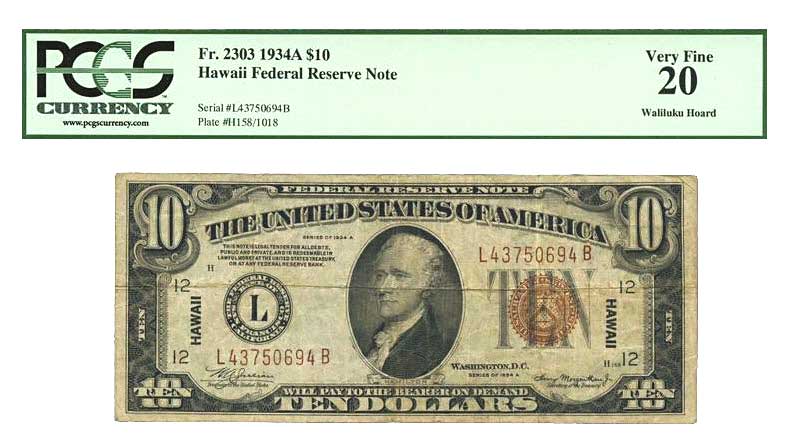 | ||||
| Wall of Greed Hoard | $182,000 of 1920's notes found in the wall of a Lakewood, Ohio house by a contractor renovating a bathroom. See: Cash Hidden in Ohio House Walls Becomes Contractor's Nightmare.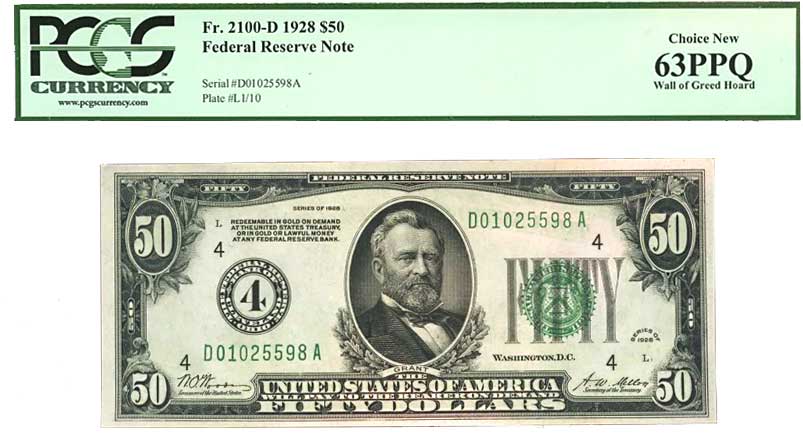
| ||||
| Wet Printing | Method of printing currency on wet sheets of paper, widely used by the BEP prior to Series 1957, and which often results in minor size and design differences, along with a slight rippled texture, due to varying shrinkage between ink and paper drying. |